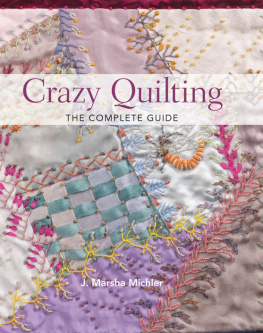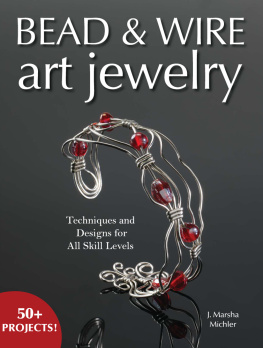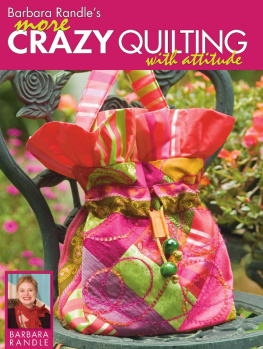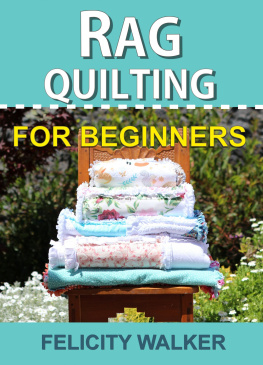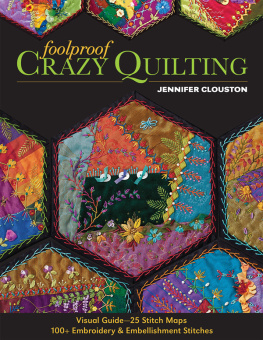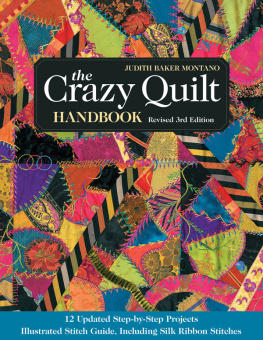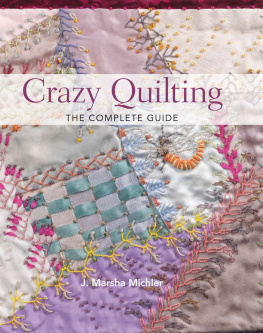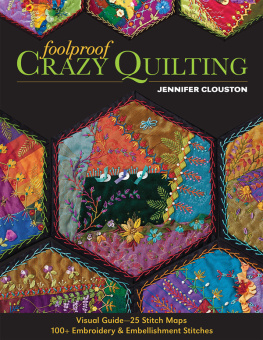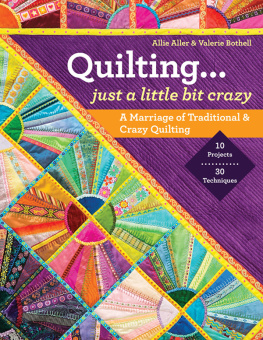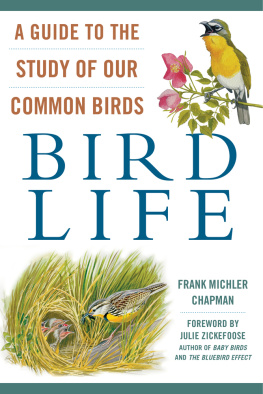J. Marsha Michler - Crazy Quilting - The Complete Guide
Here you can read online J. Marsha Michler - Crazy Quilting - The Complete Guide full text of the book (entire story) in english for free. Download pdf and epub, get meaning, cover and reviews about this ebook. year: 2008, publisher: KP Craft, genre: Home and family. Description of the work, (preface) as well as reviews are available. Best literature library LitArk.com created for fans of good reading and offers a wide selection of genres:
Romance novel
Science fiction
Adventure
Detective
Science
History
Home and family
Prose
Art
Politics
Computer
Non-fiction
Religion
Business
Children
Humor
Choose a favorite category and find really read worthwhile books. Enjoy immersion in the world of imagination, feel the emotions of the characters or learn something new for yourself, make an fascinating discovery.
- Book:Crazy Quilting - The Complete Guide
- Author:
- Publisher:KP Craft
- Genre:
- Year:2008
- Rating:5 / 5
- Favourites:Add to favourites
- Your mark:
- 100
- 1
- 2
- 3
- 4
- 5
Crazy Quilting - The Complete Guide: summary, description and annotation
We offer to read an annotation, description, summary or preface (depends on what the author of the book "Crazy Quilting - The Complete Guide" wrote himself). If you haven't found the necessary information about the book — write in the comments, we will try to find it.
Crazy Quilting - The Complete Guide — read online for free the complete book (whole text) full work
Below is the text of the book, divided by pages. System saving the place of the last page read, allows you to conveniently read the book "Crazy Quilting - The Complete Guide" online for free, without having to search again every time where you left off. Put a bookmark, and you can go to the page where you finished reading at any time.
Font size:
Interval:
Bookmark:
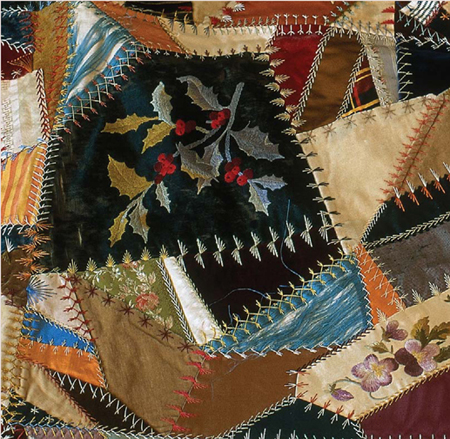
This vintage crazy quilt features beautiful motif embroideries. Detail. Museum Collection, Dyer Library/Saco Museum, Saco, Maine.
The art quilt of the Victorian Age is revived for modern times with an updated, fresh look but with its roots intact. It is still a means of self expression for needle artists. It still has us gawking over fine fabrics and gorgeous threads; still has us searching for what to do with an old piece of ribbon, or how to dye or paint a piece of cotton lace so it blends into a motif. In a way, little has changed in more than one hundred years.
This book is intended as a reference; that is why projects are featured as examples of techniques without instructions. For project instructions, please refer to my other books and those of other authors.
Use this reference to learn some new skills, hone some beloved old ones, and for suggestions and inspiration. Use these ideas to tweak your quilts and crazy projects with colorful dimension and textures. Enjoy!
What is Crazy Quilting?
Crazy quilting is a creative form of quilting in which patches are made in irregular shapes and sizes. In most methods, patching is worked on a foundation fabric, which displaces the traditional quilt batting. A crazy patched piece is oft en treated to embroidery and embellishments and is traditionally tied, not running-stitch quilted.
Choose Your Expertise Level
Beginner: Start with cotton muslin foundation, fabrics that hold a crease and are easy to work with, such as cottons, rayons, and linens. Beginners find size 8 pearl cotton the easiest thread for embroidering.
Intermediate: Experiment with incorporating silks and a greater variety of all fabric types. Try other threads, such as rayons and silks, for embroidery. Dabble with all of the embellishment techniques. Be willing to experiment and expand your horizons.
Advanced: Make an all-silk quilt. Use silk organza fabric for a foundation, hand-dyed silk fabrics, and silk threads for embroidery. Work on refining you techniques in any of the embellishment methods.
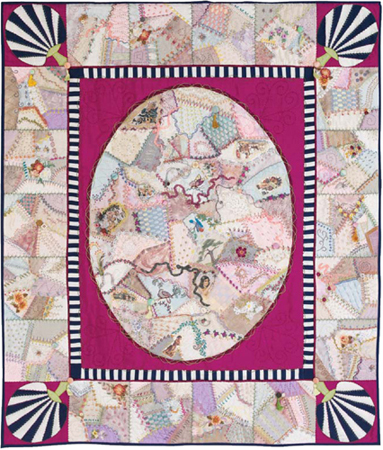
A Thousand Stitches combines several concepts that are covered on the following pages: whole-quilt center, block-style border, checkerboard sashing, corner block fans, and edges finished with a binding.
Your patching method is a determinant in the style of a quilt. Machine methods, for instance, are easier to do on smaller areas, so blocks are the answer. The Antique method lends itself to large areas, making the whole-quilt style appropriate. Strip-patching creates bands that can be sewn vertically or in other directions.
Other aspects of quilt design involve dividing the quilt top into areas separated by sashings, using pieced fans in various ways, and whether to add a border. These elements not only determine how the area of the quilt top is used, but they are important to the decor of the quilt as well. Borders, for instance, can be patchwork or treated to appliqu, embroidery, or other design work. Working embroidery on sashings softens them and adds to the detail of the quilt.
Browse through this section, then sketch some of your own quilt ideas. Putting outlines on paper will help you to visualize a finished quilt. Decide how large you want the quilt, then figure what size to make each area. Add an amount of seam allowance for sewing the pieces together. Cut out foundation fabric for each piece. Even if a piece is not crazy patched, it should be backed with the same foundation fabric as the patched areas so all parts will be more equal to each other.
The parts of a quilt can be sewn together after blocks are patched and before embroidery, or after the blocks are completely finished. It all depends on how you prefer to work. After the quilt top is assembled, consider working a line of embroidery along each seam. This helps the seams to blend and is an opportunity to work meandering vines with leaves and silk ribbon flowers.
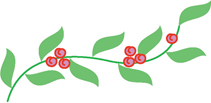
Blocks divide a quilt top into manageable portions. The blocks for a quilt top can be made square or rectangular, large or small. Mix block sizes in a quilt, or make them all the same size.
There is no standard block size. Some people find 6 square blocks too small to work on, while others thrive on small areas. You will have to find what works best for you.
A perceived drawback of this style (for some) is that the quilt appears to consist of blocks. And why not, if it is? If you wish to conceal this fact, leave some patches hanging at the edges and appliqu them onto the adjoining block after blocks are sewn together. Or, elegantly blend them by working lines of embroidery over the seams.
Use a seam allowance that you are comfortable with, and that is in scale with the project. I usually use for a miniature quilt, and for a larger piece and for most non-quilt projects. If a wider allowance creates too much fabric in the seam, it can always be trimmed back after sewing.
Pressing Seams
With heavier fabrics and patched foundations, pressing seams open prevents excessive bulk. It's usually best to press a seam open if you will be working embroidery along it.
Take-up
Take-up is the bunching that can occur as embroidery or other work is done. It can oft en be prevented. In patching or piecing, press carefully and check that the foundation is staying flat. In embroidery and embellishing use a hoop for hand work, and stabilizer for machine work. Some fabrics such as velveteen tend to crawl. This can be minimized by basting across in several directions. If, no matter what you do bunching still occurs, then cut your foundations larger to account for it.
The whole-quilt style pairs well with hand patching methods such as the Antique and the Landscape methods. Unlike dividing the quilt top into blocks, the whole quilt style is worked as one unit and finishes as one. This presents an incredible opportunity to not only view the quilt as a landscape-like entity, but also to work on the whole piece at once. This changes the work order. Instead of completing a block at a time, a larger area evolves more gradually as one unit.
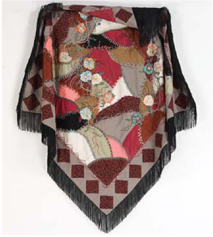
Note that the whole quilt style allows the top to become a one-unit composition.
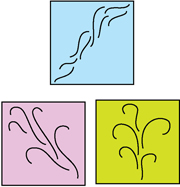
Possible patterns of embellishment distribution across a whole-quilt top.
Strips are bands running part or all the length or width of a quilt. They can be placed horizontally, vertically, or diagonally. Strips result naturally from the Strip Patching method, but can be made using any other patching method as well. Use them exclusively, or combine them with blocks or sashings.
Sashings are narrow strips of plain fabric 1 to 3 wide. Use them to keep blocks or strips separate from each other. Make sure the width of the sashings is appropriate for the quilt. Sashings can be patchwork as in the quilt, A Thousand Stitches.
Font size:
Interval:
Bookmark:
Similar books «Crazy Quilting - The Complete Guide»
Look at similar books to Crazy Quilting - The Complete Guide. We have selected literature similar in name and meaning in the hope of providing readers with more options to find new, interesting, not yet read works.
Discussion, reviews of the book Crazy Quilting - The Complete Guide and just readers' own opinions. Leave your comments, write what you think about the work, its meaning or the main characters. Specify what exactly you liked and what you didn't like, and why you think so.

